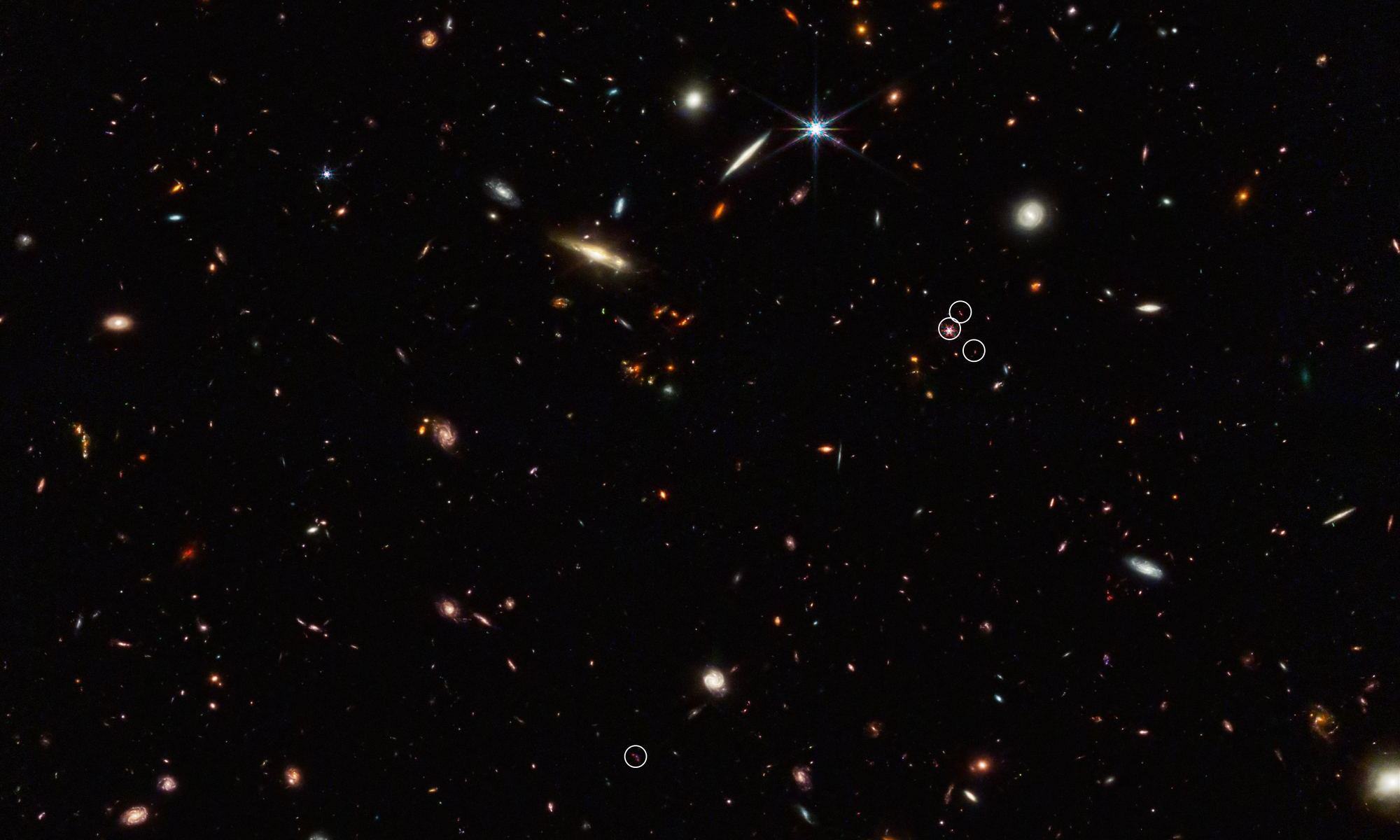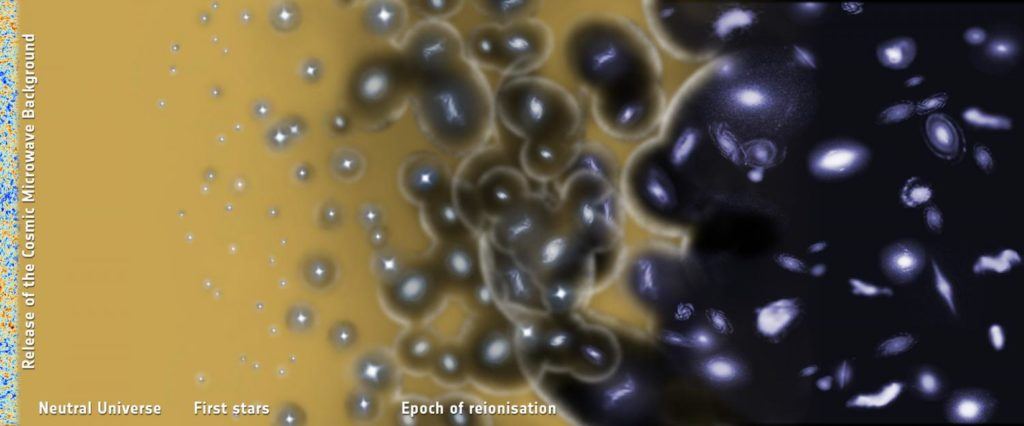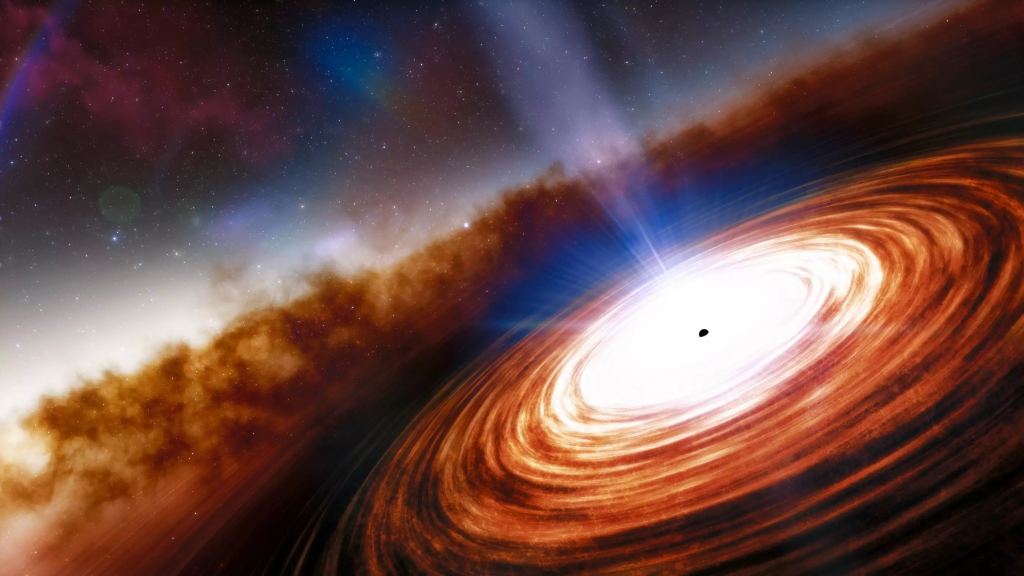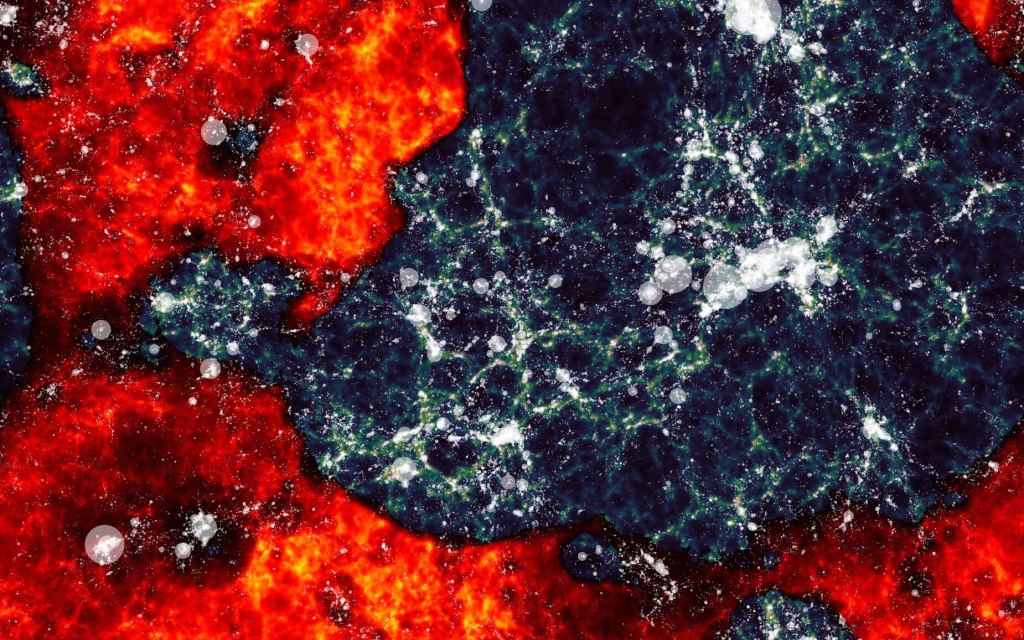This deep galaxy field from Webb’s NIRCam (Near-Infrared Camera) shows an arrangement of 10 distant galaxies marked by eight white circles in a diagonal, thread-like line. (Two of the circles contain more than one galaxy.) This 3 million light-year-long filament is anchored by a very distant and luminous quasar – a galaxy with an active, supermassive black hole at its core. The quasar, called J0305-3150, appears in the middle of the cluster of three circles on the right side of the image. Its brightness outshines its host galaxy. The 10 marked galaxies existed just 830 million years after the big bang. The team believes the early filament of the Cosmic Web will eventually evolve into a massive cluster of galaxies. Credit: NASA, ESA, CSA, Feige Wang (University of Arizona

The Cosmic Web is the large-scale structure of the Universe. If you could watch our cosmos unfold from the Big Bang to today, you’d see these filaments (and the voids between them) form throughout time. Now, astronomers using JWST have found ten galaxies that make up a very early version of this structure a mere 830 million years after the Universe began.
The “cosmic web” started as density fluctuations in the very early Universe. A few hundred million years after the Big Bang, matter (in the form of primordial gas) had condensed into knots at the intersections of sheets and filaments of gas in the early web. These knots and filaments hosted the first stars and galaxies. It’s only natural that as astronomers look back in time, they would seek out the early versions of the cosmic web. JWST allowed them to look back at very faint, dim objects that existed shortly after the Big Bang.
The ten galaxies the team spotted are aligned in a thin, three million light-year-long thread anchored by a bright quasar. Its appearance surprised the team both for its size and its place in cosmic history. “This is one of the earliest filamentary structures that people have ever found associated with a distant quasar,” added Feige Wang of the University of Arizona in Tucson, the principal investigator of this program.
Aspiring to Understand the Early Universe and the Cosmic Web
The JWST observations are part of an observation program called ASPIRE: A SPectroscopic survey of biased halos in the Reionization Era. It uses both images and spectra of 25 quasars that existed back when the Universe was starting to light up after the “Dark Ages.” The idea is to study the formation of the very earliest galaxies possible, as well as the births of the first black holes. In addition, the team hopes to understand how the early universe was enriched with heavier elements (the metals), and how it all played out during the epoch of reionization.

The ASPIRE goals are an important part of understanding the origin and evolution of the Universe. “The last two decades of cosmology research have given us a robust understanding of how the cosmic web forms and evolves. ASPIRE aims to understand how to incorporate the emergence of the earliest massive black holes into our current story of the formation of cosmic structure,” explained team member Joseph Hennawi of the University of California, Santa Barbara.
Focus on the Early Black Holes
Quasars beckon across time and space. They’re powered by supermassive black holes which produce incredible amounts of light and other emissions, along with powerful jets. Astronomers use them as standard candles for distance measurements, as well as a way to study the vast regions of space their light passes through.

At least eight of the quasars in the ASPIRE study have black holes that formed less than a billion years after the Big Bang. These black holes have masses of between 600 million to 2 billion times the mass of the Sun. That’s really quite massive and raises a lot of questions about their rapid growth. “To form these supermassive black holes in such a short time, two criteria must be satisfied. First, you need to start growing from a massive ‘seed’ black hole. Second, even if this seed starts with a mass equivalent to a thousand Suns, it still needs to accrete a million times more matter at the maximum possible rate for its entire lifetime,” explained Wang.
For these black holes to grow as they did, they needed a lot of fuel. Their galaxies were also quite massive, which could explain the monster black holes in their hearts. Not only did those black holes suck in a lot of material, but their outflows also affect star formation. “Strong winds from black holes can suppress the formation of stars in the host galaxy. Such winds have been observed in the nearby universe but have never been directly observed in the Epoch of Reionization,” said Yang. “The scale of the wind is related to the structure of the quasar. In the Webb observations, we are seeing that such winds existed in the early universe.”
Why the Epoch?
We often hear about astronomers wanting to look back at the Epoch of Reionization. Why is it such a tantalizing target? It offers a look at a time when the first stars and galaxies formed. After the Big Bang, the infant Universe was in a hot, dense state. Sometimes we hear it referred to as the primordial soup of the cosmos. Then, expansion took over and things began to cool. That allowed electrons and protons to combine to make the first neutral atoms of gas. It also allowed thermal energy from the Big Bang to propagate. Astronomers detect that radiation. It’s redshifted into the microwave portion of the electromagnetic spectrum. Astronomers call it the “cosmic microwave background” radiation (CMB).

This aspect of the early Universe had tiny fluctuations of density in its expanding material. That material was neutral hydrogen. There were no stars or galaxies, yet. But, eventually, these higher-density areas began to clump together under gravity, which caused the neutral matter began to clump, too. That led to the further collapse of the high-density areas, which eventually led to the birth of the first stars. They heated the surrounding material, which punched holes in the neutral regions—and that allowed light to travel. Essentially, those holes (or bubbles) in the neutral gas allowed ionizing radiation to travel farther through space. It was the beginning of the Epoch of Reionization. By a billion years after the Big Bang, the Universe was fully ionized.
So, How to Explain the Early Supermassive Black Holes?
It’s interesting that those early galaxies JWST found, along with their quasars, were already fully in place, with supermassive black holes at their cores. That key question remains: how did they get so big so fast? Their existence may tell astronomers something about the “overdensities” in the infant cosmos. First, the black hole “seed” needs an overdense region filled with galaxies in order to form.
So far, however, observations before the JWST discovery found only a few galaxy overdensities around the earliest supermassive black holes. Astronomers need to do more observations at this epoch to explain why that might be. The ASPIRE program should help resolve questions about the feedback between galaxy formation and black hole creation in this very early epoch of the Universe. Along the way, they should also see more fragments of the large-scale structure of the Universe’s cosmic web as they form.
